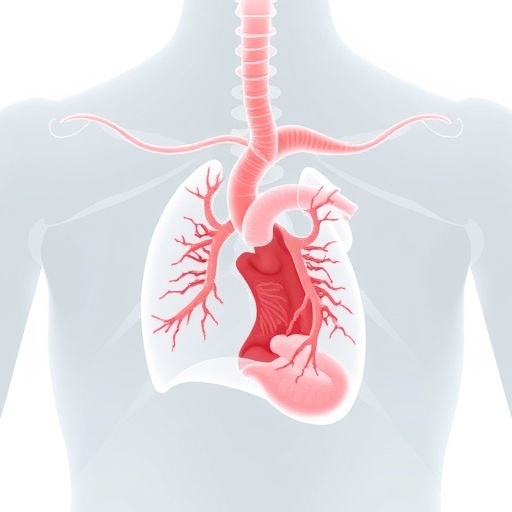
In a groundbreaking advancement poised to reshape the treatment landscape for heart failure, a recent study elucidates the remarkable potential of tirzepatide in patients suffering from Heart Failure with preserved Ejection Fraction (HFpEF). Published in Nature Communications, this pivotal research employs a target trial emulation within a retrospective cohort framework to rigorously evaluate the therapeutic effectiveness of this novel agent in a clinical context that has long posed significant treatment challenges.
HFpEF, a complex cardiovascular syndrome characterized by the heart’s inability to adequately fill despite normal contractile function, affects millions globally and has resisted effective pharmacological intervention. The heterogeneous underlying pathophysiology and frequent comorbidities render many conventional heart failure treatments insufficient or inconclusive for this population. Hence, the quest for viable, evidence-based therapies remains one of cardiology’s most pressing challenges.
Tirzepatide, a dual glucose-dependent insulinotropic polypeptide (GIP) and glucagon-like peptide-1 (GLP-1) receptor agonist, originally developed and approved for type 2 diabetes management, has emerged as a promising candidate beyond glycemic control. Preclinical studies have hinted at its potential cardiometabolic benefits, but large-scale, methodologically sound clinical evaluations in the context of HFpEF had been lacking—until now. The study’s methodological innovation lies in leveraging target trial emulation techniques to mimic randomized controlled trials (RCTs) rigorously within real-world data, enabling a more precise estimation of tirzepatide’s effect on HFpEF outcomes than traditional observational studies often can.
Utilizing extensive electronic health records and meticulously curated patient data, Lin, Liao, Yu, and colleagues identified a well-defined cohort of HFpEF patients treated with tirzepatide, comparing them to matched controls who did not receive the drug. By emulating the inclusion, exclusion, and follow-up protocols akin to a randomized design, the authors minimized confounding and immortal time bias, challenges notoriously inherent in retrospective analyses. This methodological stringency provides robustness to their conclusions and sets a new standard for pharmacoepidemiologic research in cardiovascular medicine.
The study’s findings demonstrate significant improvements in clinical endpoints among tirzepatide users, encompassing enhanced exercise capacity, reduced hospitalization rates, and improved biomarkers reflective of cardiac stress and inflammation. These outcomes suggest that tirzepatide’s multimodal mechanism—combining incretin receptor agonism with favorable metabolic and anti-inflammatory effects—might mitigate the multifactorial pathogenesis of HFpEF more effectively than existing therapies.
Mechanistically, tirzepatide’s activation of GLP-1 and GIP receptors modulates several pathways critical to cardiovascular homeostasis. Beyond glycemic regulation, these pathways influence endothelial function, myocardial energetics, and adipose tissue inflammation, all of which play pivotal roles in HFpEF progression. The drug’s ability to reduce systemic inflammation and ameliorate metabolic derangements could disrupt the vicious cycle that perpetuates myocardial stiffening and diastolic dysfunction in HFpEF.
Importantly, the investigators highlight that tirzepatide’s benefits were most pronounced in patient subgroups characterized by obesity, metabolic syndrome, and insulin resistance, underscoring the interplay between metabolic health and cardiac performance. This stratification emphasizes the necessity of personalized therapeutics targeting the underlying metabolic-inflammatory axis in HFpEF, a paradigm shift away from the “one-size-fits-all” approach traditionally employed.
Safety data from the analysis were reassuring, with no significant increase in adverse events attributable to tirzepatide, even in this medically complex population. Gastrointestinal side effects, consistent with prior diabetes trials, were the most commonly reported but generally mild and self-limiting. This safety profile could ease concerns regarding polypharmacy and tolerability among elderly HFpEF patients, often plagued by multiple comorbidities.
Beyond clinical efficacy and safety, this study’s design has broader implications for cardiovascular research. Target trial emulation offers a powerful tool to harness real-world data for rapid, cost-effective evaluation of emerging therapies, particularly when conducting large-scale RCTs proves logistically or ethically challenging. This approach can accelerate the translation of scientific discoveries into practice-changing evidence, ultimately enhancing patient care.
Despite these promising results, the authors prudently call for prospective randomized trials to confirm tirzepatide’s benefits and elucidate optimal dosing strategies and treatment durations. The retrospective nature of the current analysis, while mitigated by sophisticated statistical methods, cannot entirely eliminate residual confounding or establish causality with absolute certainty.
Furthermore, they advocate for mechanistic studies combining imaging, biomarker profiling, and hemodynamic assessments to further dissect tirzepatide’s multifaceted effects on cardiac morphology and function. Addressing these knowledge gaps will enrich understanding of HFpEF heterogeneity and guide precision medicine approaches.
The study also prompts reflections on clinical practice and guideline development. Should subsequent trials corroborate these findings, tirzepatide could represent the first disease-modifying pharmacotherapy specifically effective for HFpEF, transforming a previously therapeutic void into a realm of hope for patients and clinicians alike.
Moreover, the potential cardiometabolic synergy offered by agents like tirzepatide reinforces the critical need to integrate metabolic management in treating cardiovascular diseases. This integration addresses root causes rather than symptoms alone, signaling a new era in heart failure therapeutics.
In summary, Lin and colleagues’ innovative application of target trial emulation to evaluate tirzepatide provides compelling evidence for its efficacy in HFpEF, a condition notoriously resistant to pharmacological intervention. Their study contributes a seminal piece to the evolving puzzle of heart failure treatment, with far-reaching implications for research methodology, clinical practice, and patient outcomes.
As the scientific and medical communities eagerly await corroboration from ongoing randomized controlled trials, this landmark study already sets the stage for a paradigm shift. Tirzepatide’s dual incretin receptor agonist profile, coupled with its metabolic and anti-inflammatory benefits, might finally offer a lifeline to patients burdened by HFpEF, redefining the future of heart failure management.
This landmark work not only pushes the boundaries of therapeutic innovation but also exemplifies the power of real-world data analytics combined with rigorous causal inference techniques. It marks a transformational moment in cardiometabolic research, offering a glimpse into a future where precision medicine and data-driven insights converge to tackle complex chronic diseases effectively.
The road ahead is paved with challenges, including validating these findings across diverse populations, integrating new treatments into multifaceted care pathways, and ensuring equitable access. Yet, the promise heralded by tirzepatide for HFpEF patients shines brightly, signaling a hopeful dawn in a domain long marked by clinical uncertainty and unmet need.
Subject of Research: The effectiveness of tirzepatide in the treatment of Heart Failure with preserved Ejection Fraction (HFpEF) using a target trial emulation retrospective cohort study.
Article Title: Effectiveness of tirzepatide in patients with HFpEF using a target trial emulation retrospective cohort study.
Article References:
Lin, YM., Liao, KM., Yu, T. et al. Effectiveness of tirzepatide in patients with HFpEF using a target trial emulation retrospective cohort study. Nat Commun 16, 4471 (2025). https://doi.org/10.1038/s41467-025-59616-2
Image Credits: AI Generated
Tags: cardiometabolic benefits of tirzepatidechallenges in heart failure treatmentdual GIP and GLP-1 agonistevidence-based therapies for heart failureglucagon-like peptide-1 receptor agonistheart failure with preserved ejection fractionHFpEF treatment advancementsNature Communications research on HFpEFpharmacological interventions for HFpEFretrospective cohort studytarget trial emulation in cardiologyTirzepatide for heart failure





